|
The following table of sentences represents 22 sales reports
from two branches (west and east) including volume and value of sales from two
customer groups (BUSINESS and HOME). Each report indicates a period, a salesman
and a date (of submission). The periods are in the range 1 to 10, however a
decimal representation is used here (1.0 to 10.0), to illustrate interpolation
better.
|
| sales report is submitted by branch
|
| customer group volume sales period branch code salesman date
|
|
BUSINESS 101 1020.10 1.0 west jim 12-JAN-2003
BUSINESS 100 1010.00 2.0 west anne 19-JAN-2003
BUSINESS 104 1050.40 3.0 west jim 26-JAN-2003
BUSINESS 107 1080.70 5.0 west karen 09-FEB-2003
BUSINESS 106 1070.60 6.0 west karen 16-FEB-2003
BUSINESS 110 1111.00 7.0 west jim 23-FEB-2003
BUSINESS 117 1181.70 8.0 west jim 02-MAR-2003
BUSINESS 113 1141.30 9.0 west dina 09-MAR-2003
BUSINESS 115 1161.50 10.0 west peter 16-MAR-2003
HOME 104 1050.40 3.0 west oscar 26-JAN-2003
HOME 105 1060.50 4.0 west john 02-FEB-2003
HOME 106 1070.60 6.0 west phil 16-FEB-2003
HOME 110 1111.00 7.0 west phil 23-FEB-2003
HOME 112 1131.20 8.0 west phil 02-MAR-2003
HOME 113 1141.30 9.0 west phil 09-MAR-2003
HOME 104 1050.40 3.5 east mia 29-JAN-2003
HOME 115 1161.50 5.0 east mia 05-FEB-2003
HOME 106 1070.60 6.0 east mia 12-FEB-2003
HOME 110 1111.00 7.0 east wolf 19-FEB-2003
HOME 112 1131.20 8.0 east john 26-FEB-2003
HOME 113 1141.30 8.5 east wolf 05-MAR-2003
HOME 103 1040.30 9.5 east john 12-MAR-2003
|
|
|
Interpolation, Selection
and Accumulation Procedures
|
|
Interpolation
|
|
We are interested in analyzing the sales reports for period 1 to
10. However, there are several gaps in the series of periods, the two HOME
series additionally have missing reports both from the start and end of the
analysis period, besides "odd" reporting periods (3.5, 8.5 and 9.5).
We will use interpolation to create estimates for the missing reports, and to
"straighten up" the data, such that there is one report for each
customer group from each branch for each period 1 to 10. We have entered one
sentence which defines the analysis period:

|
|
The sentence type we want
to derive (the interpolated sentences) is sales
report is estimated by branch. The
following rule is defining this derivation: |
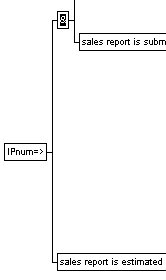 |
| Note
the following particulars of the above rule: |
| Interpolations
are based on a series of sentences. The series is defined by the number
argument element parameter to the
interpolation
procedure, i.e. the
period
data element, the
series-start and series-end
parameters which define the boundaries of the
series, and finally the series-step parameter
which defines the increments for the
steps in the series. Given the estimation
period is used sentence
above, this means the series 1,2,3,...,10. The interpolation procedure
is assigned to the conclusion data element which corresponds to the series
- it follows from this that use of the interpolation procedure mandates
the use of such a data element in the concluded sentence type. |
| Consider
the assignments between the customer group data element in the conclusion
with the same data element in the condition, and the similar assignments
for the branch code data element. These two assignments have the effect
that interpolation is carried for the series of periods separately for
each combination of customer group and branch (all in all three BUSINESS/
west, HOME/east and HOME/west). |
| The
extrapolation parameter (to the
INTERPOLATION procedure) is
EXTRAPOLATE_AT_START_AND_END, i.e.
sentences at the head and tail of the series will be added as
required. |
| The
PREDECESSOR sub-procedure used for
volume specifies that interpolated
sentences should use the volume value from the predecessor-sentence in the
series. The MIDPOINT sub-procedure used for
sales specifies that
interpolated sentences should use the midpoint between the predecessor and
successor sentences' value for sales. |
| The
FIXED procedure used for salesman and data specify that "n/a"
and 0 respectively should be used as value for these two data elements in
interpolated sentences. |
The rule derives the
following sentences:
| sales report is estimated by branch
|
| customer group volume sales period branch code salesman date
|
BUSINESS 101 1020.10 1.0 west jim 12-JAN-2003
BUSINESS 100 1010.00 2.0 west anne 19-JAN-2003
BUSINESS 104 1050.40 3.0 west jim 26-JAN-2003
BUSINESS 104 1065.55 4.0 west n/a 26-JAN-2003
BUSINESS 107 1080.70 5.0 west karen 09-FEB-2003
BUSINESS 106 1070.60 6.0 west karen 16-FEB-2003
BUSINESS 110 1111.00 7.0 west jim 23-FEB-2003
BUSINESS 117 1181.70 8.0 west jim 02-MAR-2003
BUSINESS 113 1141.30 9.0 west dina 09-MAR-2003
BUSINESS 115 1161.50 10.0 west peter 16-MAR-2003
HOME 104 1050.40 1.0 east n/a 29-JAN-2003
HOME 104 1050.40 2.0 east n/a 29-JAN-2003
HOME 104 1050.40 3.0 east n/a 29-JAN-2003
HOME 104 1105.95 4.0 east n/a 29-JAN-2003
HOME 115 1161.50 5.0 east mia 05-FEB-2003
HOME 106 1070.60 6.0 east mia 12-FEB-2003
HOME 110 1111.00 7.0 east wolf 19-FEB-2003
HOME 112 1131.20 8.0 east john 26-FEB-2003
HOME 113 1090.80 9.0 east n/a 05-MAR-2003
HOME 103 1040.30 10.0 east n/a 12-MAR-2003
HOME 104 1050.40 1.0 west n/a 26-JAN-2003
HOME 104 1050.40 2.0 west n/a 26-JAN-2003
HOME 104 1050.40 3.0 west oscar 26-JAN-2003
HOME 105 1060.50 4.0 west john 02-FEB-2003
HOME 105 1065.55 5.0 west n/a 02-FEB-2003
HOME 106 1070.60 6.0 west phil 16-FEB-2003
HOME 110 1111.00 7.0 west phil 23-FEB-2003
HOME 112 1131.20 8.0 west phil 02-MAR-2003
HOME 113 1141.30 9.0 west phil 09-MAR-2003
HOME 113 1141.30 10.0 west n/a 09-MAR-2003 |
No extrapolation
If we had specified NO_EXTRAPOLATION
to the extrapolation parameter instead of EXTRAPOLATE_AT_START_AND_END, the result would have been
as follows (and quite different from the previous rule):
| sales report is estimated by branch
|
| customer group volume sales period branch code salesman date
|
BUSINESS 101 1020.10 1.0 west jim 12-JAN-2003
BUSINESS 100 1010.00 2.0 west anne 19-JAN-2003
BUSINESS 104 1050.40 3.0 west jim 26-JAN-2003
BUSINESS 104 1065.55 4.0 west n/a 26-JAN-2003
BUSINESS 107 1080.70 5.0 west karen 09-FEB-2003
BUSINESS 106 1070.60 6.0 west karen 16-FEB-2003
BUSINESS 110 1111.00 7.0 west jim 23-FEB-2003
BUSINESS 117 1181.70 8.0 west jim 02-MAR-2003
BUSINESS 113 1141.30 9.0 west dina 09-MAR-2003
BUSINESS 115 1161.50 10.0 west peter 16-MAR-2003
HOME 104 1050.40 3.5 east mia 29-JAN-2003
HOME 104 1105.95 4.5 east n/a 29-JAN-2003
HOME 115 1116.05 5.5 east n/a 05-FEB-2003
HOME 106 1090.80 6.5 east n/a 12-FEB-2003
HOME 110 1121.10 7.5 east n/a 19-FEB-2003
HOME 113 1141.30 8.5 east wolf 05-MAR-2003
HOME 103 1040.30 9.5 east john 12-MAR-2003
HOME 104 1050.40 3.0 west oscar 26-JAN-2003
HOME 105 1060.50 4.0 west john 02-FEB-2003
HOME 105 1065.55 5.0 west n/a 02-FEB-2003
HOME 106 1070.60 6.0 west phil 16-FEB-2003
HOME 110 1111.00 7.0 west phil 23-FEB-2003
HOME 112 1131.20 8.0 west phil 02-MAR-2003
HOME 113 1141.30 9.0 west phil 09-MAR-2003 |
|
|
Accumulation
|
|
We are also interested in
the accumulated sales and volume figures over the analysis period. We want to
accumulate separately for each customer group and
branch:
|
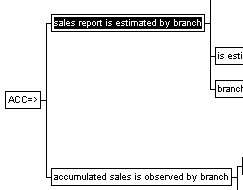 |
| Note
the following particulars of the above rule: |
| Consider
first the assignments between the customer group data element in the conclusion
with the same data element in the condition, and the similar assignments
for the branch code data element. These two assignments have the effect
that accumulation is carried for the series of periods separately for
each combination of customer group and branch (all in all three BUSINESS/
west, HOME/east and HOME/west). (Accumulation separately for each period
would be meaningless, since as is described under, period is used as the
series-element in the accumulation. Correspondingly, the assignments to
period in the conclusion simply assigns it the values of the
series-element). |
| There
are two calls to the ACCUMULATION_OF
procedure
corresponding to the two data elements we want to accumulate (sales
and volume).
Each call specifies the data element to be accumulated and the series-element
which is period.
The actual increments are determined by the actual sentences defined by
the condition. It is important to note that only one sentence per
series occurrence (= period)
is considered. period)
is considered. The
procedure will simply ignore other sentences with the same period. In
relation to the above example, it would not be possible to accumulate
totals per period for e.g. all branches directly (i.e. without using
another rule to total per period for all branches). Note
also that in cases like the above rule where more than one accumulation is
carried out, then the series-element
parameter must be the same. |
|
|
The rule derives the
following accumulated sales is observed by
branch sentences:
| accumulated sales is observed by branch |
| customer group sales volume period branch code |
BUSINESS 1020.10 101 1.0 west
BUSINESS 2030.10 201 2.0 west
BUSINESS 3080.50 305 3.0 west
BUSINESS 4146.05 409 4.0 west
BUSINESS 5226.75 516 5.0 west
BUSINESS 6297.35 622 6.0 west
BUSINESS 7408.35 732 7.0 west
BUSINESS 8590.05 849 8.0 west
BUSINESS 9731.35 962 9.0 west
BUSINESS 10892.85 1077 10.0 west
HOME 1050.40 104 1.0 east
HOME 2100.80 208 2.0 east
HOME 3151.20 312 3.0 east
HOME 4257.15 416 4.0 east
HOME 5418.65 531 5.0 east
HOME 6489.25 637 6.0 east
HOME 7600.25 747 7.0 east
HOME 8731.45 859 8.0 east
HOME 9822.25 972 9.0 east
HOME 10862.55 1075 10.0 east
HOME 1050.40 104 1.0 west
HOME 2100.80 208 2.0 west
HOME 3151.20 312 3.0 west
HOME 4211.70 417 4.0 west
HOME 5277.25 522 5.0 west
HOME 6347.85 628 6.0 west
HOME 7458.85 738 7.0 west
HOME 8590.05 850 8.0 west
HOME 9731.35 963 9.0 west
HOME 10872.65 1076 10.0 west |
|
|
Maximum and minimum
selection
|
|
Let's consider again the
original sales report is submitted by branch
sentences above. We want to know the highest sale regardless of customer group
and branch:
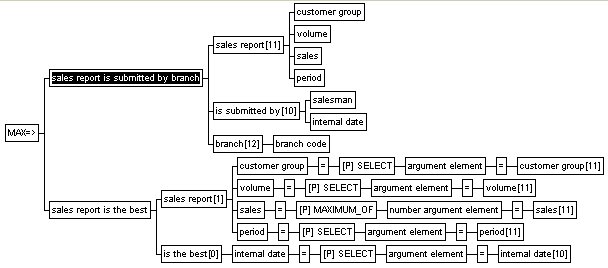
| Note
the following particulars of the above rule: |
| There
is one call to the MAXIMUM_OF
procedure, which selects the sentence in the condition with the highest
sales value. This sentence is used as source for all values assigned to
the data elements in the conclusion, through the
MAXIMUM_OF call assigned to the sales
data element, as well as to remaining conclusion data elements which are
assigned value through the SELECT
sub-procedure. It will be evident from the next example why the select
rule must be used and not simple assignments. |
The rule concludes the following sentence (NL-format):
sales report with customer group BUSINESS, volume 117, sales 1181.70 and period 8.0 is the best for date 02-MAR-2003!
Let's assume that we
instead are interested in the best sales figures for each customer group. This
is achieved by changing the rule, such that an equaliy condition is set between
the customer group data element in the conclusion and the customer group in the
condition:
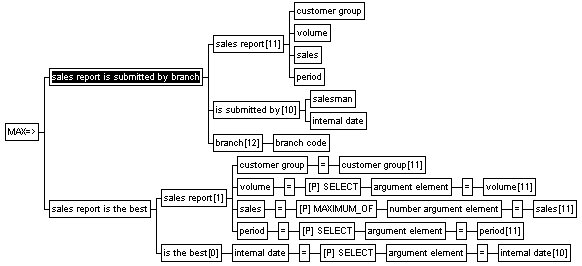
This rule would derive the
following sentences:
sales report with customer group BUSINESS, volume 117, sales 1181.70 and period 8.0 is the best for date 02-MAR-2003!
sales report with customer group HOME, volume 115, sales 1161.50 and period 5.0 is the best for date 05-FEB-2003!
Minimum selection works in exactly
the same manner as maximum selection.
|
|
Ranking
|
|
We also want to rank the submitted
sales reports in order of decreasing sales. This is handled by the ranking
procedure:
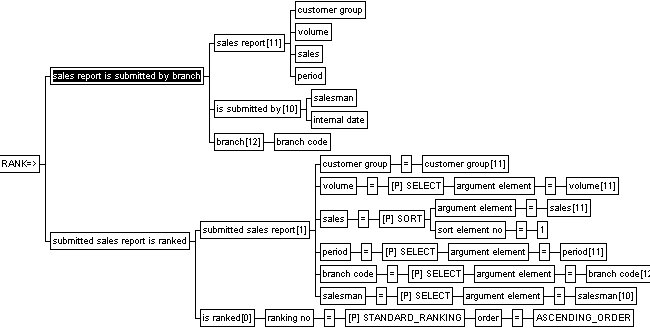
| Note
the following particulars of the above rule: |
| There
is one call to the STANDARD_RANKING
procedure, which indicates which data element in the conclusion to be
assigned the ranking. The
sort
procedure states that the ranking is based on value of the
sales
data element in the condition set (and also that these sales data elements
are assigned to the similarly named data element in the conclusion ). Note
that several sort data elements can be used. The
sort element no
parameter indicates the relative significance of the elements (i.e. 1 is
the most significant sorting element). The
select
procedure calls work in the same way as described
for the MAXIMUM_OF
procedure above. |
The rule concludes the following sentences:

The results would have been as
follows if the statistical ranking
procedure is used in place of the standard ranking
procedure. The difference is the treatment of ties (the rankings are fixed point
numbers):
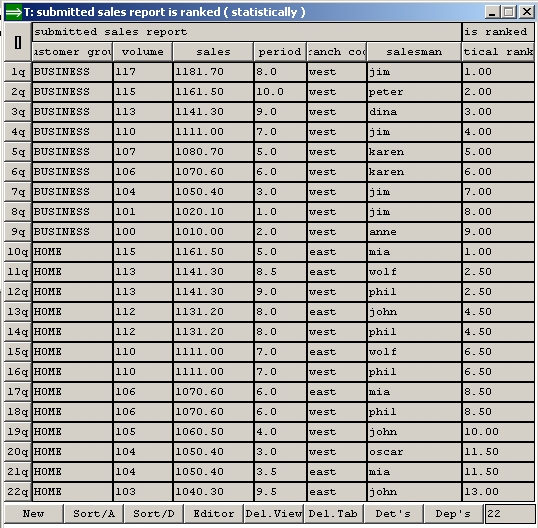
|
|
Unique selection
|
|
We want to select sales reports
which have been submitted by salesmen with only one report submission. The
unique rule can be used for this:
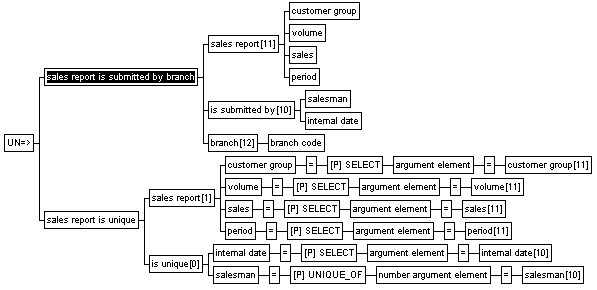
| Note
the following particulars of the above rule: |
| There
is one call to the UNIQUE_OF
procedure, which selects sentences in the condition with unique values for
the
salesman
data element. The SELECT
procedure calls work in the same way as described
for the MAXIMUM_OF
procedure above. |
The rule concludes the following sentences:

If we were interested in
"unique salesmen" per branch and customer group, then we would have to
use an equality condition between the respect data elements in the conclusion
and condition in place of the select procedure calls.
|









